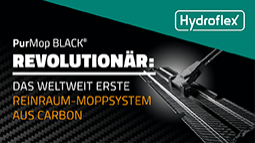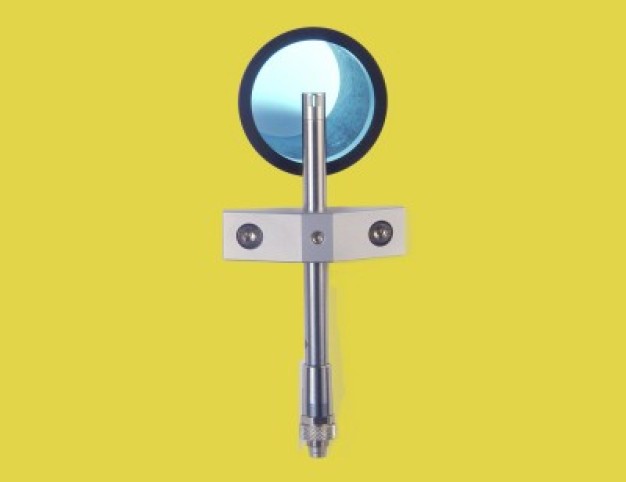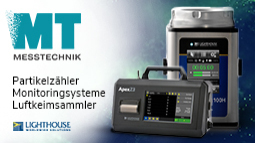Überwachung der Raumüberströmung
Einführung
Ein neuer Strömungssensor aus dem Hause SCHMIDT Technology wartet mit gänzlich neu-en Eigenschaften auf. In einem sehr schlanken Metallgehäuse verbirgt sich eine thermische Strömungssonde, die sowohl die Strömungsrichtung detektieren kann als auch die Strö-mungsgeschwindigkeit in zwei Richtungen messen kann. Diese Sonde tritt an, um im Bereich der Reinraumtechnik die Strömungsüberwachung deutlich zu verbessern. Einer der Anwendungsfälle ist die Überwachung der Raumüberströmung. Dieser Bericht möchte aufzeigen, was sich hinter dem Begriff Raumüberströmung verbirgt, mit welchen Mitteln die Raumüberströmung bisher festgestellt wurde und wie die Raumüberströmung mit Hilfe die-ses neuen Sensors verbessert werden kann.
Raumüberströmung, was ist das ?
Werden in Reinräumen Produkte offen verarbeitet, dann muss häufig sichergestellt werden, dass kontaminierte Luft aus den Nachbarräumen nicht in diesen Raum eindringt und dadurch die offenen Produkte schädigt. Das kann man entweder dadurch sicherstellen, dass die Räume homogen geschlossen werden (Isolatortechnik) oder dadurch, dass man eine zwangsweise Überströmung der Luft aus dem zu schützenden Raum in den angrenzenden Raum sicherstellt. Zu diesem Zweck wird in dem zu schützenden Raum ein Luftüberdruck aufgebaut und infolge dessen wird durch jede vorhandene Raumöffnung die Luft nach außen strömen und somit das Eindringen kontaminierter Luft verhindert. Zur Aufrechterhaltung die-ser stabilen Situation reicht es in der Regel aus, eine kontinuierliche Zuluft in den mit Über-druck versehenen Raum zu leiten und mit Hilfe eines Differenzdrucksensors den Raum auf konstanten Überdruck zu regeln. Bei Überdrücken größer als 15 Pascal und bei nahezu dicht geschlossenen Räumen ist das gut zu machen.
Handelt es sich aber um einen Raum, der über häufig zu öffnende Türen verfügt oder über große Öffnungen in der Wand z.B. für Produktförderbänder, dann kann häufig eine derart große Druckdifferenz gar nicht gehalten werden. Bei diesen Räumen wird folgerichtig mit sehr geringen Überdrücken gearbeitet und die Produktsicherheit dadurch gewährleistet, dass man an Stelle des Differenzdruckes die überströmende Luft zwischen den Räumen über-wacht. Ist bereits eine geeignete Wandöffnung vorhanden, dann kann man in dieser Öffnung eine Messeinrichtung anbringen. Anderenfalls wird eine spezielle Überströmöffnung in der Wand angebracht.
Um bewerten zu können, wie sich der Raumdifferenzdruck auf die Geschwindigkeit der Überströmung auswirkt, kann in erster Näherung das ?Torricelli?sche Ausflussgesetz? verwen-det werden, wenn man berücksichtigt, dass diese Betrachtung eine dünne Wandung und ein Loch ausreichender Größe voraussetzt.
w=Wurzel aus ( 2 x delta p / p )
wobei:
w = Strömungsgeschwindigkeit m/s
delta p = Differenzdruck [Pa]
p = Dichte des Mediums [kg/m^3]
Unter den Bedingungen einer Raumluft mit 20°C bei einem Standardluftdruck von 1013,25 hPas ergibt die Berechnung den nachfolgenden Zusammenhang:
Differenzdruck [Pa] Geschwindigkeitw [m/s]
0,01 0,13
0,1 0,41
1 1,29
5 2,89
10 4,08
15 5,00
20 5,77
30 7,07
An Hand dieser Berechnung kann man erkennen, dass ein in der Überströmungsöffnung an-gebrachter Strömungssensor selbst dann noch eine Überströmung nachweisen kann, wenn nur noch sehr kleine Differenzdrücke vorhanden sind.
Bisherige Lösungen
Die sicherste Lösung, um Rückströmungen zwischen Räumen zu verhindern ist ?wie bereits gesagt- die, einen möglichst hohen Differenzdruck aufzubauen. In pharmazeutischen Rein-räumen sind Differenzdrücke zwischen 15 und 30 Pascal üblich. Dass der eingestellte Diffe-renzdruck die geforderte Überströmung erzeugt wird bei den Abnahmeprüfungen durch die Visualisierung der Strömung mit Hilfe von Rauchpartikeln nachgewiesen. Zur dauernden Ü-berwachung der Überströmung werden häufig Differenzdrucksensoren eingesetzt, die nach-weisen, dass der erforderliche Differenzdruck dauernd aufrechterhalten wird. Die Schwach-stelle dieser Lösung ist, dass das Messsignal dieser Sensoren bei sehr kleinen Differenzdrü-cken unstabil wird und somit dazu zwingt, einen relativ hohen Druck aufrecht zu erhalten. Al-ternativ werden in speziell eingebrachten Wandöffnungen Windfahnen eingesetzt, an denen man die Strömungsrichtung ablesen kann. Leider ist diese Version auch relativ unempfind-lich und wegen der nicht vorhandenen elektrischen Schnittstelle auch nicht über das elektro-nische Monitoringsystem einzubinden. Alternativ werden teilweise auch normale Strömungs-sensoren eingesetzt, die in der Überströmungsöffnung aufgestellt werden. Leider können diese Sensoren nicht erkennen, in welche Richtung die Strömung fließt.
Das Funktionsprinzip des neuen Sensors
Der Strömungs-Sensor SS 20.400 ist der erste Sensor aus dem Hause SCHMIDT dessen Sensorelement dir Richtung einer strömenden Luft erkennen kann. Dieser Sensor arbeitet nach dem Prinzip des thermischen Anemometers (auch Hitzedraht-Prinzip genannt). Die thermischen Anemometer unterscheiden sich durch die nachfolgenden Vorteile von anderen Luftströmungsmessern:
- minimalste Strömungsgeschwindigkeiten sind messbar (ab 0,05 m/s)
- keine bewegten Teile und somit keine Abnutzung
- sehr geringer Strömungswiderstand b.z.w. geringer Druckabfall an Messstelle
Der neue Sensor vom Typ SS 20.400 hat noch einige weitere Vorteile aufzuweisen, die sich uns im Folgenden erschließen.
Element und Elektronik im Miniformat
Zum Schutz gegen mechanische Belastung hat SCHMIDT das Sensorelement in eine Kam-mer eingebaut, das ganze wird dann ?Kammerkopf? genannt. Durch eine sorgfältige aerody-namische Gestaltung dieses Kammerkopfes wurde dafür gesorgt, dass auch eine unsaubere Montage des Sensors (leichtes Verdrehen zur Strömungsachse oder Verkippen gegen die Sensorachse) eine geringstmögliche Rückwirkung auf das Messergebnis hat. Im Fühlerrohr direkt hinter dem Sensorelement sitzt die superkleine Auswerteelektronik, sie suchen also vergeblich nach einem externen Messumformer. Den Kern der Elektronik bildet ein Mikro-prozessor, der über folgende Anschlüsse mit der Außenwelt verbunden ist: Analogausgang 4? 20 mA/ 0..10 V, Richtungsausgang, Schwellwertausgang (beide als Open Collector) und RS 232 Schnittstelle. Der Analogausgang liefert ein lineares Ausgangssignal sowohl bei vorwärts als auch rückwärts strömender Luft. Über die serielle Schnittstelle kann der Anwen-der den Sensor genau auf seine Bedürfnisse einstellen. Dazu bietet SCHMIDT Technology ein Programmierkit, das über einen PC einfach zu bedienen ist.
Die Vorteile des neuen Sensors
· Eindeutige Richtungserkennung
· Messen in zwei Richtungen
· Sehr schnelles Ansprechverhalten im ms Bereich
· Schaltausgänge eingebaut
daher auch als Wächter zur direkten Alarmgebung einsetzbar
· Sehr geringe Abmessungen
· Über PC parametrierbar
· Eingebaute Verschmutzungserkennung
· GMP geeignete Materialien
Technische Daten
Bauform: Eintauchsonde (Ø 9 x 150 mm incl. Stecker),
Messumformer im Fühlerrohr integriert.
Einsatzbereich: Frei strömende Luft und geführte Luft in Rohren von 15 bis 1.000 mm
Messbereiche: 1 / 2,5 / 10 / 20 m/s (in beide Richtungen)
Messbereichsanfang: 0,05 m/s
Druck: atmosphärisch, 700 .. 1300 hPa
Montage: wahlweise Wandhalterung, Flansch oder Durchgangsverschraubung
Versorgung: 12 ? 24 VDC / unter 10 mA
Ausgänge: 0 / 4 ... 20 mA , 0..10 V, 0..5 V,
2 Open Collector- Ausgänge für Richtung und Schwellwert
RS 232 zur Parametrierung
Die Anwendung des neuen Sensors
Der SCHMIDT Strömungssensor SS 20.400 besitzt alle Eigenschaften, um die zuvor er-wähnte Überströmung zuverlässig überwachen zu können. Zur Montage des Sensors vor der Überströmungsöffnung gibt es einen passenden Wandmontageflansch. In diesen wird die dünne Sonde eingeschraubt und so justiert, dass das Fühlerelement in der Mitte der Öffnung zu liegen kommt und dass der Fühlerschlitz mit der Achse der Öffnung fluchtet. Mit Hilfe des Analogausganges kann jetzt die Geschwindigkeit der durch die Überströmöffnung fließenden Luft überwacht werden. Da der Sensor bereits ab 0,05 m/s misst kann eine Überströmung auch dann noch nachgewiesen werden, wenn der Differenzdruck schon nicht mehr eindeutig messbar ist. Kann der Sensor keine Vorwärtströmung mehr nachweisen oder findet gar eine Rückströmung statt, dann meldet er diesen Zustand über seinen Schaltausgang OC1.
Mit Hilfe des Programmierkits kann der Anwender das Analogsignal des Sensors dämpfen und die Schaltschwellen der Schaltausgänge selbst einstellen. Hierdurch kann der Sensor für jeden Anwendungsfall ideal konfiguriert werden.
Der neue Sensor wird in verschiedenen Varianten angeboten. Damit erschließen sich ihm noch weitere Anwendungsmöglichkeiten im Bereich der Reinraumtechnik:
Laminarflow-Überwachung
Volumenstrom-Messung in Zu- und Abluftkanälen
Kühlluftüberwachung
Strömungskontrolle in Schutzgasatmosphären
Fazit
Der Strömungssensor SS 20.400 erschließt für das Strömungs-Monitoring in Reinräumen neue Möglichkeiten. Besonders für die Überwachung der Raumüberströmung kann dieser Sensor die folgenden Pluspunkte verbuchen:
· Stabiles Messsignal auch bei kleinsten Differenzdrücken
· Vermeidung vorschneller Alarme
· Einfache Montage
· Leicht zu reinigen im eingebauten Zustand
· Schneller Ein- und Ausbau (z.B. zur Kalibrierung)
· Kalibrierung in jedem guten Windkanal möglich
Verweise:
Stöcker, Taschenbuch der Physik , 2. Auflage 1994

SCHMIDT Technology GmbH
Feldbergstraße 1
78112 St. Georgen / Schwarzwald
Germany
Phone: +49 7724 899198
Fax: +49 7724 899101
email: o.joos@schmidttechnology.de
Internet: http://www.schmidttechnology.de









